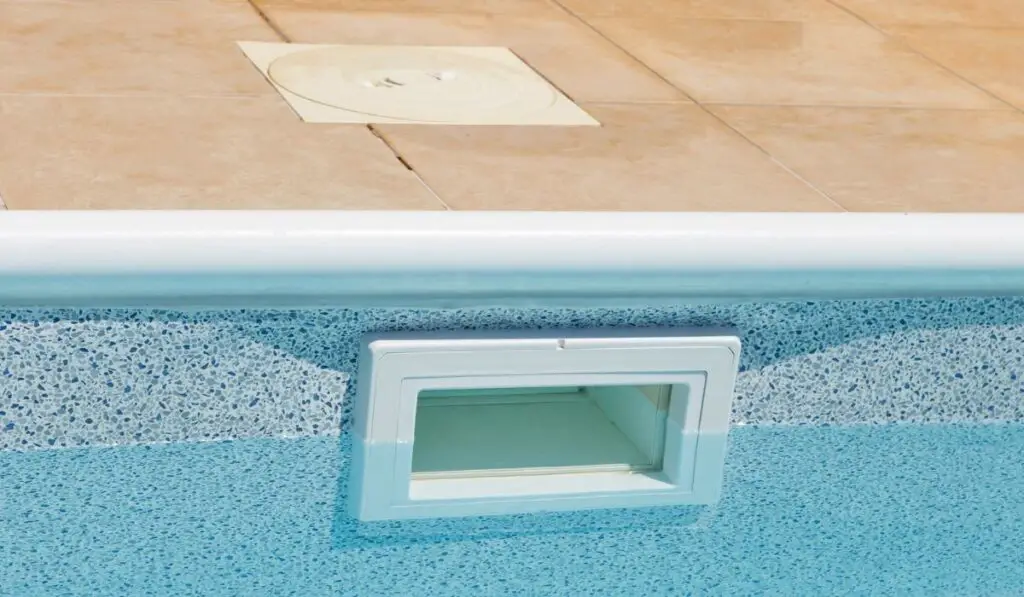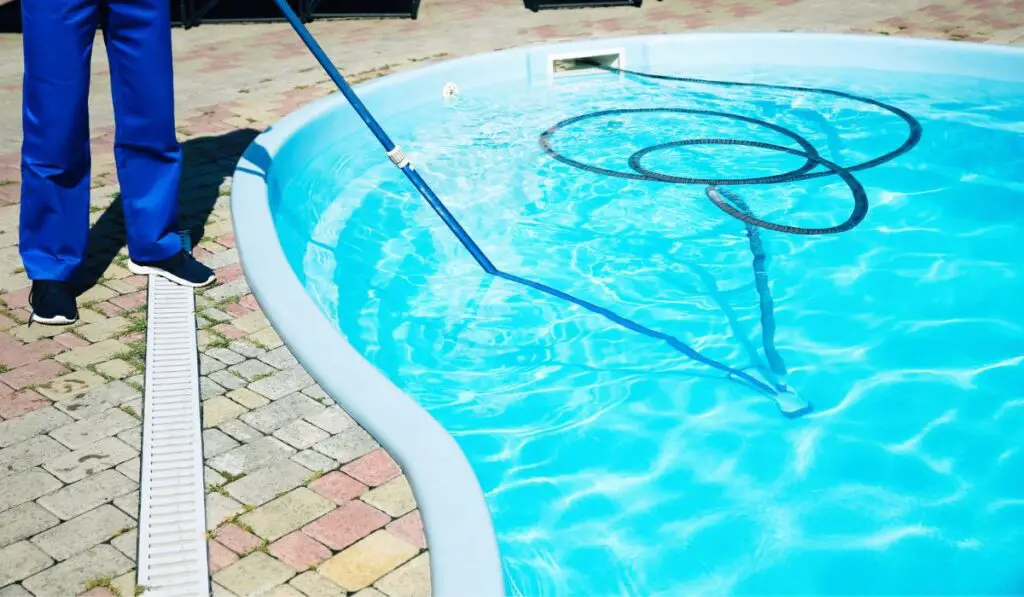Most times, you can rely on your hand skimmer to pick up all the dirt and debris floating around your pool. However, sometimes things like an algae infestation or a big storm blowing massive amounts of debris into your pool call for a change in your pool cleaning tactics. So, can you vacuum a pool using a skimmer?
You can vacuum your pool using a skimmer by attaching your vacuum hose to the vac head and the skimmer. This will create a powerful siphon that can pull contaminants in your pool through the vacuum head up the hose into the skimmer and then through the filter system.
Let’s take a look at how pool skimmers work, the different types of skimmers available, and how to set up a manual pool vacuum through the skimmer.
What Is a Pool Skimmer?

A pool skimmer is a filter that seizes floating dirt and debris before they sink to the bottom of your pool. It’s one of the most important components that you can find in every pool.
Pool skimmers draw water from the surface and suck it through the pool’s filtration system. Skimmers draw in about the top one-eighth inch of water to help get rid of contaminants, like leaves and hair, before they sink to the bottom. You won’t even notice this because the suction power is so discreet.
Maintaining your skimmer is vital for your pool’s health. If your skimmer isn’t fully functional, it won’t eliminate debris and chemicals from your pool properly. Consequently, your pool will end up cloudy and swarmed with algae.
Moreover, your pool pump will be susceptible to wear and tear, meaning you’ll have to replace it before the recommended date. This can be a costly exercise.
What Are the Different Types of Pool Skimmers?
There are three different types of pool skimmers. They include:
Floating Skimmers
Floating skimmers are most common in above-ground pools. Some pool owners have them attached to a pool vacuum. These skimmers randomly hover around the pool, collecting debris from the surface.
Robotic Skimmers
Robotic pool skimmers are an alternative to stationary skimmers. They are usually fully or semi-automated and battery or solar-powered. These skimmers use the energy to effortlessly glide around the pool, collecting dirt, debris, and bugs.
In-Wall Pool Skimmers
In-wall pool skimmers are tiny, rectangular and built into the side of your pool. You can access the skimmer through a trap door or hatch on the pool deck area. The hatch is typically made of PVC or precast concrete. Inside the skimmer is a basket that holds all the dirt and debris skimmed from the pool water.
The in-wall skimmer also has a door over the front side called a weir, which pulls in just the top, thin layer of water. The weir opens and closes depending on the level and movement of water in the pool. What’s more, it closes when you turn off your pump to prevent the debris collected in the skimmer basket from floating back into the pool.
You should fit your skimmer with an equalizer line that runs from the skimmer basket through the wall of your pool and into the water. The equalizer line is vital in blocking air from getting into the pool’s filtration system if the water level drops below the skimmer weir. If air enters the system, it may damage the pool pump.
Keep in mind that skimmers don’t just collect the gross stuff from your pool’s surface. By eliminating huge debris, skimmers help the filter do a better job removing other smaller contaminants, making your pool even cleaner.
Some in-wall skimmers also have automatic chlorinators, which improve your overall pool sanitation.
How to Set up a Pool Vacuum Through the Skimmer
To set up a pool vacuum through the skimmer, you’ll need to gather the following equipment:
- A vacuum head (on Amazon)
- A skim vac or vacuum plate (On Amazon) (optional)
- A telescopic pole (on Amazon) that’s long enough to reach the deepest parts of your pool
- A vacuum hose (on Amazon) that’s also able to reach all parts of your pool
Once you have them on hand, follow these steps:
- Attach the vacuum head to the telescoping pole.
- Attach one end of the vacuum hose to the outlet fitting on your vacuum head.
- Submerge the vacuum head to the bottom of your pool.
- Push your entire vacuum hose underwater until it fills with water. By doing this, you’ll eliminate air from your vacuuming components that can otherwise make your pump lose its prime if it gets into the pump’s intake line.
- You’ll notice air bubbles rising from your vacuum head on your pool floor. When the bubbles stop, there’s no more air in the hose.
How to Vacuum a Pool

Now that you’ve set up all the equipment, it’s time to vacuum your pool. Here’s what to do:
First, you’ll have to attach the vacuum plate to the end of the hose you initially placed against the return jet. Block the opening with your hand and bring it next to the skimmer. Put it in the skimmer on top of the basket and ensure you create a good seal, or you’ll lose suction.
If you don’t have a vacuum plate, remove the skimmer basket and use your hand to block the end of your water-filled hose. Next, put the hose in the skimmer inlet, making sure you firmly insert it into the suction hole at the bottom of the skimmer.
Now that you’ve made a powerful siphon using your filter system, it’s time to vacuum. Kick off at the shallow end and work your way up to the deep end. Start at one side and move across the floor if your pool is round.
Sweep over the floor with long, slow strokes. Ensure your strokes overlap slightly, so you don’t leave any debris behind. Rushing will kick up debris that will settle back later, and you’ll have to vacuum again. In case the water becomes cloudy, give it a few hours to clear up, then head back and continue vacuuming.
If the vacuum head gets stuck at some point, turn off the pump for a second to interrupt the vacuum force. Also, keep an eye on your pool filter’s pressure gauge while vacuuming. If the pressure rises above the level recommended by the manufacturer, ease off and backwash your filter.
Cleaning After Vacuuming
After vacuuming your entire pool, clean it thoroughly so you can get back to swimming. Here’s how to do it:
- Detach the vacuum head from the telescoping pole and drain any water remaining in the vacuum hose.
- Attach your cleaning brush to the telescoping pole and scrub off any dirt, algae and debris on the sides of your pool.
- Remove any debris in your pump strainer basket and backwash the filter.
- If you were vacuuming on the “Waste” setting, switch the multiport valve back to the “Filter” setting and continue adding fresh water to your pool until you restore the normal water level.
- Once you’ve topped off your pool water, test it and adjust the pH, alkalinity, and chlorine as necessary.
- Rinse all your equipment, dry them, and put them back in storage. This will help keep them in optimum working condition and prevent wear and corrosion.
